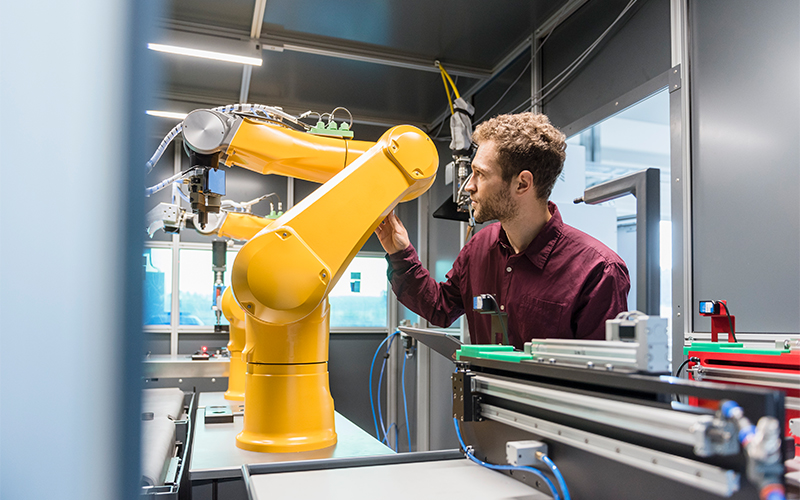Business Transformation
The Role of AI/ML in the manufacturing sector
Before we delve into the role of Artificial Intelligence (AI) and Machine Learning (ML) in the manufacturing sector, let us take a brief look at the evolution of the manufacturing industry. This will help us understand and better appreciate the role of AI/ML in this sector. The manufacturing industry moved from manual activities to mechanization with the introduction of steam and water power. This innovation facilitated addressing the demand vs. supply gap. This was followed by the introduction of assembly lines. Assembly lines drastically helped increase output and bring down the prices of the products. This was significantly seen in the automotive industry.
The next big innovation was going digital with partial automation, aided by the advent of computers. It resulted in mass production due to a combination of various technologies and processes like IC chips, microprocessors, the internet, etc. Today, the manufacturing industry is at a fast-paced evolutionary phase, as technology is changing rapidly. The Internet of Things (IoT), robots, AI, cloud computing, etc. have opened up vast possibilities, spearheading manufacturing to new heights. Every change has been dictated by consumer needs that demand better quality, speed, flexibility, accuracy, intelligence, and safety. Without all these factors, trusting a driverless car or a robotic surgery can be tough indeed. Humans love automation, but not at the cost of lives!
A compelling case
Currently, the market of AI in manufacturing is sizeable. What is more compelling is that it is anticipated to grow at a steady CAGR, in spite of the setbacks seen by the manufacturing sector due to Covid-19 lockdowns. The key factor pushing manufacturers to adopt AI/ML is the need to achieve better operational efficiency. The lack of a skilled workforce and the pandemic constraints also add to this need. Major manufacturers across the globe are already relying on AI to enhance product quality. It is also helping them achieve better visibility across the distribution network and supply chain. Additionally, AI is scoring big in energy management by cutting wastage and mitigating costs.
Historically, the success of manufacturing has always been linked to the economy of the countries. It leads to higher GDP, lower unemployment rates and better lives overall. Therefore, manufacturers need to realise this and create value by empowering their workforce using AI/ML-based applications. Creating an optimal human-machine collaborative ecosystem can help harness the power of both. The benefits are already visible in many sectors like transportation, healthcare, finance and, of course, manufacturing.
The immense benefits
AI helps not just with improved operational efficiency and hyper-productivity in plants.* It also helps design better products and reduces downtime with data-driven insights collected from multiple sensors. These insights help a lot with smart maintenance, which is preventive rather than reactive. It makes for improved worker safety in plants and drives productivity in tandem with environment-friendly options. Predictive analytics utilising the power of ML help create statistical models for production and equipment degradation forecasts. Prescriptive analytics using the power of ML helps analyse multiple scenarios for better decision-making.
Raw material and overall process optimisation is another critical aspect of using AI/ML in manufacturing. AI-based predictive analytics also helps in inventory and demand fluctuation management. Another core benefit of AI is quality control. The control systems aided by multiple technologies such as computer vision and context-aware computing converge into neural networks that help identify defective products at every stage. These are just a few examples, and the applications are evolving by the day.
How can organisations make the best use of AI/ML in manufacturing?
AI/ML-based applications work best when the complete data to be utilised is aggregated at a central location. The centralised data can be used for real-time monitoring and data visualisation to gain useful insights to aid decision-making. This data collated across time is what AI annotation services use for creating and training models used for analytics and predictions. Therefore, it is important to ensure that there is a robust and scalable data infrastructure. Utilising robotic process automation services or data annotation services from reputed providers is another way to make the most out of your data.
It is not enough to deploy AI/ML-based applications and expect a huge turnaround. It is equally important to employ a highly trained and intelligent workforce that can utilise it well. The human intelligence angle is essential to know which data to collect and why. Only if the impact of the data and the insights gained from it is known can these systems produce the expected results. This might mean that there should be an organisational shift to a data-driven culture where every employee sees the value in it. Essentially, these systems too are part of the continuous improvement process. Hence, the best benefits can be gained only along with human intelligence to monitor, assess, and make necessary changes, when applicable.
* For organizations on the digital transformation journey, agility is key in responding to a rapidly changing technology and business landscape. Now more than ever, it is crucial to deliver and exceed on organizational expectations with a robust digital mindset backed by innovation. Enabling businesses to sense, learn, respond, and evolve like a living organism, will be imperative for business excellence going forward. A comprehensive, yet modular suite of services is doing exactly that. Equipping organizations with intuitive decision-making automatically at scale, actionable insights based on real-time solutions, anytime/anywhere experience, and in-depth data visibility across functions leading to hyper-productivity, Live Enterprise is building connected organizations that are innovating collaboratively for the future.






